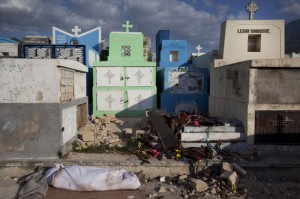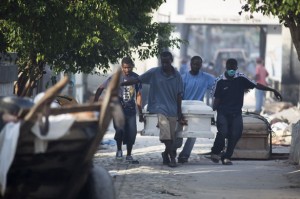How can a country in the grip of an apocalyptic tragedy deal in a dignified way with its victims?
Paul Harris, The Guardian (January 17, 2010)
The current stories emanating from Haiti are incomprehensibly awful. This Guardian article uses the word apocalyptic and that seems utterly appropriate.
A crisis situation of this enormity is compounded by the sheer number of immediate human needs. One of those key requirements is the rapid identification, removal, and burial of dead bodies. The problem in Haiti is that an already weak infrastructure is unable to handle the number of dead bodies produced by the earthquake. In this crisis situation, the normalized rules for handling the dead cannot cope with all the corpses.
And yet, something must be done with the dead bodies.
Part of the assistance being sent by the United States involves dispatching Disaster Mortuary Organizational Response Teams or DMORT groups to Haiti. DMORT is part of the US Department of Health and Human Services and specializes in handling mass fatality situations. These are the kinds of individuals on DMORT Teams (as listed on the HHS website):
funeral directors, medical examiners, coroners, pathologists, forensic anthropologists, medical records technicians and transcribers, finger print specialists, forensic odontologists, dental assistants, x-ray technicians, mental health specialists, computer professionals, administrative support staff, and security and investigative personnel.
Here is an article about a University of Florida Forensic Entomologist, Dr. Jason Byrd, who is already in Haiti with a DMORT group.
Private companies are also sending groups to Haiti. The main provider of mass disaster/fatality services in the private sector is Kenyon International Emergency Services. Kenyon is based in Houston, TX and owned by Service Corporation International (SCI). SCI is the largest global provider of funeral, cemetery, and cremation services and got into the mass fatality business in the mid-2000’s. I will write more about SCI and Kenyon at a later date.
For right now, both DMORT and Kenyon will be attempting to do the following things:
1.) Identify any of the dead that they can
2.) bury the dead in an organized fashion
3.) use a tagging system of some kind so that the dead can be (possibly) identified at a later date.
These tasks are made vastly more complicated by the rush to bury bodies in mass graves. There is a common misconception that dead bodies spread disease. That’s not entirely true and this CNN article covers these points. What dead bodies do create is a terrible smell. Decomposing dead bodies are also difficult to look at. When you multiply these problems by 100,000 dead bodies (this is just the body count estimate at this point) then immediate disposal of the corpses becomes easier to understand.
The following video clip from CNN sums up the situation:


8 replies on “The Impossibility of Identifying the Dead in Haiti”
Kenyon international should be activated. They only sent a 20 person team per there web site. They did the tsunami and Katrina and did a great job. They have all the resources and can activate there full teams and be there in no time. Give the job to the pro’s and get it done right. Kenyon is the worlds largest disaster team and been around for 100 yrs. SOmeone needs to tell the right people to activate them now before more people end up lost in mass graves. Pass it on, look at there site!
I think it was Kenyon personel in New Orleans that took known people from known locations-didnt document either and dropped them off at DMORT operations where they became unknowns. Doesnt sound very professional to me.
DMORT is NOT in Haiti identifying or even attempting to identify bodies. They have a 4 person assessment team working to try to convince the gov’t of Haiti to allow them to go in, but to date they have NO operation in place.
I also concur with the above statement about Kenyon International. They had anything BUT professionals working in Louisiana following Hurricane Katrina. I won’t give details, but the above statement about lost identities is TRUE. As well as some very poor practices when transporting remains. There was NOTHING professional about them.
The following statementes are my opinion and I speak for no none else. Life is precious and the bodies we attach to each life is precious and should be treated with reverence and respect. That reverence and respect needs to continue after death. I was at Katrinia and I saw first hand how Kenyon treated deceased human remains. They litterally THREW bodies into body bags, face up, face down, it did not matter. No Kenyon person had any respect at all for the dead, or for the living for that matter. When a family member of mine dies,no matter where, KEEP KENYON AWAY ! They do not know the meaning of professionalism.
I am a licensed funeral director who as well has a great deal of experience in running retorts. I am willing to go to Haiti to assist at any time. Just tell me how I can help these people, DMORT or any others that my need my many years of expeience.
I have read the interesting comments regarding Kenyon. I have been in the fortunate position to be both a Team Member of Kenyon and one of their clients. In my experience having deployed with Kenyon on three occasions this is THE most professional company that I have ever had the pleasure to work with. Kenyon is the only company that doesn’t just TALK about mass fatality management but actually get’s down and dirty and get’s on with the work. There are too many ‘experts’ out there in coats and ties who make a lot of consultancy bucks but they are really only peddling a sit-by-the-fireside academic view of the world. They have little or none real-world experience. Kenyon has worked in the jungle, on mountainsides, at gun-point and, as currently in Haiti, in very arduous conditions. They know their business but most of all they take care of their staff and they are single minded in their pursuit of the compassionate return of fatal victims to their families. I would guess that many of the negative comments above come from dismissed former staff or team members that could not convey Kenyon’s high standards into field conditions. Anyway, I thought the readers of this column might appreciate an alternative and first-hand view.
I too was down in LA after hurricane Katrina, and experienced the level of incompetence by Kenyon employees. I had the opportunity to ask one of their team members about his forensic experience prior to being placed on a Kenyon recovery team. He told me he had no forensic experience. Prior to being hired by Kenyon he managed a strip club.
I have First hand knowledge of Kenyon’s performance during the aftermath of Hurricane Katrina, I have years of forensic training and experience, and would never let these guys get near any scene I was working. They were unprofessional, and sloppy in the performance of their duties!